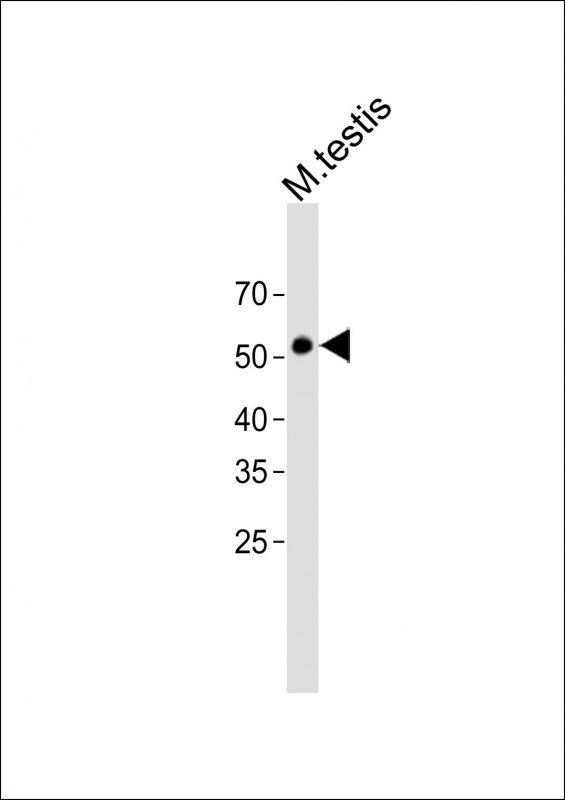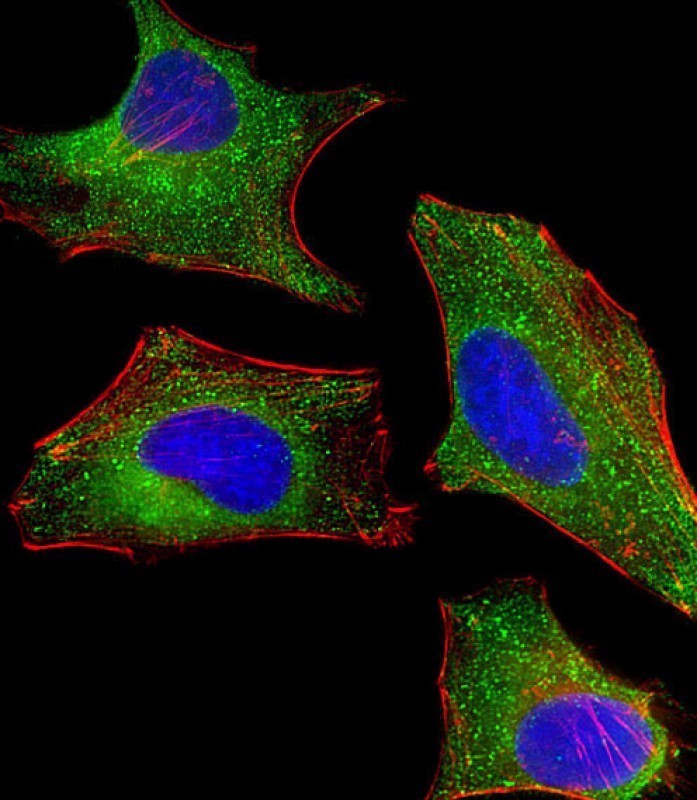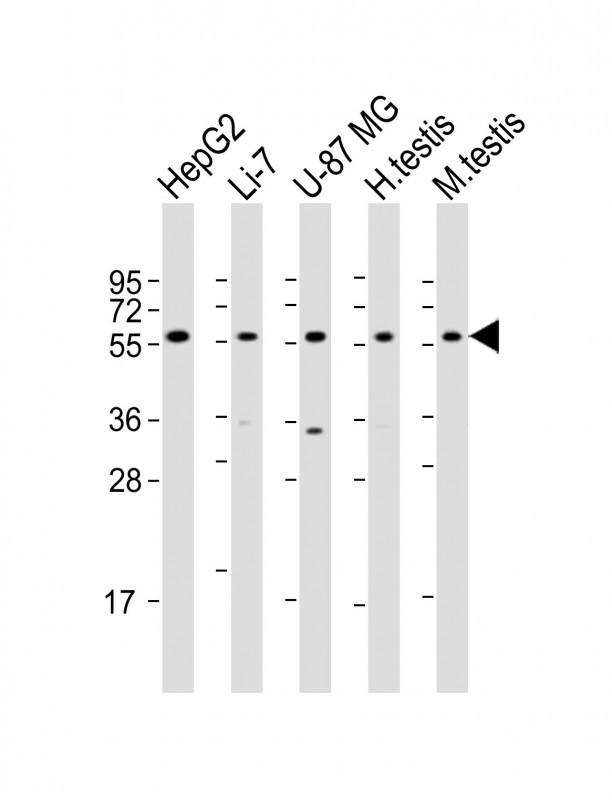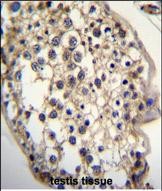DHCR7 Antibody (C-term)
Affinity Purified Rabbit Polyclonal Antibody (Pab)
- 产品详情
- 文献引用 : 1
- 实验流程
- 背景知识
Application
| WB, IHC-P, IF, E |
|---|---|
| Primary Accession | Q9UBM7 |
| Other Accession | NP_001157289.1, NP_001351.2 |
| Reactivity | Human, Mouse |
| Host | Rabbit |
| Clonality | Polyclonal |
| Isotype | Rabbit IgG |
| Calculated MW | 54489 Da |
| Antigen Region | 437-463 aa |
| Gene ID | 1717 |
|---|---|
| Other Names | 7-dehydrocholesterol reductase, 7-DHC reductase, Putative sterol reductase SR-2, Sterol Delta(7)-reductase, DHCR7, D7SR |
| Target/Specificity | This DHCR7 antibody is generated from rabbits immunized with a KLH conjugated synthetic peptide between 437-463 amino acids from the C-terminal region of human DHCR7. |
| Dilution | WB~~1:2000 IHC-P~~1:100~500 IF~~1:25 E~~Use at an assay dependent concentration. |
| Format | Purified polyclonal antibody supplied in PBS with 0.05% (V/V) Proclin 300. This antibody is purified through a protein A column, followed by peptide affinity purification. |
| Storage | Maintain refrigerated at 2-8°C for up to 2 weeks. For long term storage store at -20°C in small aliquots to prevent freeze-thaw cycles. |
| Precautions | DHCR7 Antibody (C-term) is for research use only and not for use in diagnostic or therapeutic procedures. |
| Name | DHCR7 (HGNC:2860) |
|---|---|
| Synonyms | D7SR |
| Function | Oxidoreductase that catalyzes the last step of the cholesterol synthesis pathway, which transforms cholesta-5,7-dien- 3beta-ol (7-dehydrocholesterol,7-DHC) into cholesterol by reducing the C7-C8 double bond of its sterol core (PubMed:25637936, PubMed:38297129, PubMed:38297130, PubMed:9465114, PubMed:9634533). Can also metabolize cholesta-5,7,24-trien-3beta-ol (7-dehydrodemosterol, 7-DHD) to desmosterol, which is then metabolized by the Delta(24)-sterol reductase (DHCR24) to cholesterol (By similarity). Modulates ferroptosis (a form of regulated cell death driven by iron-dependent lipid peroxidation) through the metabolic breakdown of the anti- ferroptotic metabolites 7-DHC and 7-DHD which, when accumulated, divert the propagation of peroxyl radical-mediated damage from phospholipid components to its sterol core, protecting plasma and mitochondrial membranes from phospholipid autoxidation (PubMed:38297129, PubMed:38297130). |
| Cellular Location | Endoplasmic reticulum membrane; Multi-pass membrane protein |
| Tissue Location | Widely expressed. Most abundant in adrenal gland, liver, testis, and brain. |
For Research Use Only. Not For Use In Diagnostic Procedures.

Provided below are standard protocols that you may find useful for product applications.
BACKGROUND
This gene encodes an enzyme that removes the C(7-8) double bond in the B ring of sterols and catalyzes the conversion of 7-dehydrocholesterol to cholesterol. This gene is ubiquitously expressed and its transmembrane protein localizes to the endoplasmic reticulum membrane and nuclear outer membrane. Mutations in this gene cause Smith-Lemli-Opitz syndrome (SLOS); a syndrome that is metabolically characterized by reduced serum cholesterol levels and elevated serum 7-dehydrocholesterol levels and phenotypically characterized by mental retardation, facial dysmorphism, syndactyly of second and third toes, and holoprosencephaly in severe cases to minimal physical abnormalities and near-normal intelligence in mild cases. Alternative splicing results in multiple transcript variants that encode the same protein.
REFERENCES
Bailey, S.D., et al. Diabetes Care 33(10):2250-2253(2010)
Koo, G., et al. Am. J. Med. Genet. A 152A (8), 2094-2098 (2010) :
Wang, T.J., et al. Lancet 376(9736):180-188(2010)
Ahn, J., et al. Hum. Mol. Genet. 19(13):2739-2745(2010)
Jugessur, A., et al. PLoS ONE 5 (7), E11493 (2010) :
终于等到您。ABCEPTA(百远生物)抗体产品。
点击下方“我要评价 ”按钮提交您的反馈信息,您的反馈和评价是我们最宝贵的财富之一,
我们将在1-3个工作日内处理您的反馈信息。
如有疑问,联系:0512-88856768 tech-china@abcepta.com.






















 癌症的基本特征包括细胞增殖、血管生成、迁移、凋亡逃避机制和细胞永生等。找到癌症发生过程中这些通路的关键标记物和对应的抗体用于检测至关重要。
癌症的基本特征包括细胞增殖、血管生成、迁移、凋亡逃避机制和细胞永生等。找到癌症发生过程中这些通路的关键标记物和对应的抗体用于检测至关重要。 为您推荐一个泛素化位点预测神器——泛素化分析工具,可以为您的蛋白的泛素化位点作出预测和评分。
为您推荐一个泛素化位点预测神器——泛素化分析工具,可以为您的蛋白的泛素化位点作出预测和评分。 细胞自噬受体图形绘图工具为你的蛋白的细胞受体结合位点作出预测和评分,识别结合到自噬通路中的蛋白是非常重要的,便于让我们理解自噬在正常生理、病理过程中的作用,如发育、细胞分化、神经退化性疾病、压力条件下、感染和癌症。
细胞自噬受体图形绘图工具为你的蛋白的细胞受体结合位点作出预测和评分,识别结合到自噬通路中的蛋白是非常重要的,便于让我们理解自噬在正常生理、病理过程中的作用,如发育、细胞分化、神经退化性疾病、压力条件下、感染和癌症。









